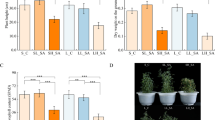Abstract
Legume roots in nature are usually colonized with rhizobia and different arbuscular mycorrhizal fungi (AMF) species. Light microscopy that visualizes the presence of AMF in roots is not able to differentiate the ratio of each AMF species in the root and nodule tissues in mixed fungal inoculation. The purpose of this study was to characterize the dominant species of mycorrhiza in roots and nodules of plants co-inoculated with mycorrhizal fungi and rhizobial strains. Glomus intraradices (GI), Glomus mosseae (GM), their mix (GI + GM), and six Mesorhizobium ciceri strains were used to inoculate chickpea. Quantitative real-time polymerase chain reaction (qRT-PCR) was used to assess occupancy of these fungal species in roots and nodules. Results showed that GI molecular ratio and relative density were higher than GM in both roots and nodules. These differences in molecular ratio and density between GI and GM in nodules were three folds higher than roots. The results suggested that M. ciceri strains have different effects on nodulation and mycorrhizal colonization pattern. Plants with bacterial S3 and S1 strains produced the highest root nodulation and higher fungal density in both the roots and nodules.







Similar content being viewed by others
References
Aliasgharzadeh N, Saleh Rastin N, Towfighi H, Alizadeh A (2001) Occurrence of arbuscular mycorrhizal fungi in saline soils of the Tabriz Plain of Iran in relation to some physical and chemical properties of soil. Mycorrhiza 11:119–122
Alkan N, Gadkar V, Coburn J, Yarden O, Kapulnik Y (2004) Quantification of the arbuscular mycorrhizal fungus Glomus intraradices in host tissue using real-time polymerase chain reaction. New Phytol 161:877–885
Alkan N, Gadkar V, Yarden O, Kapulnik Y (2006) Analysis of quantitative interaction between two species of arbuscular fungi, Glomus mosseae and G. intraradices, by real-time PCR. Appl Environ Microbiol 72(6):4192–4199
Baird LM, Caruso KJ (1994) Development of root nodules in Phaseolus vulgaris inoculated with Rhizobium and mycorrhizal fungi. Int J Plant Sci 155:633–639
Caetano-AnolleÂs G, Gresshof PM (1991) Plant genetic control of nodulation in legumes. Annu Rev Microbiol 45:345–382
Chaturvedi C, Singh R (1989) Response of chickpea (Cicer arietinum L.) to inoculation with Rhizobium and VA mycorrhiza. Proc Indian Natl Sci Acad Sect B 59:443–446
Dellaporta SL, Wood J, Hicks JB (1983) A plant DNA mini-preparation: version II. Plant Mol Biol Rep 1(14):19–21
Giovannetti M, Mosse B (1980) An evaluation of technique for measuring vesicular mycorrhizal infection in roots. New Phytol 84:489–500
Gollotte A, van Tuinen D, Atkinson D (2004) Diversity of arbuscular mycorrhizal fungi colonizing roots of the grass species Agrostis capillaries and Lolium perenne in a field experiment. Mycorrhiza 14:111–117
Hajiboland R, Aliasgharzadeh N, Farsad S, Poschenrieder C (2010) Colonization with arbuscular mycorrhizal fungi improves salinity tolerance of tomato (Solanum lycopersicum L.) plants. Plant Soil 331:313–327
Kawaguchi M, Minamisawa K (2010) Plant–microbe communications for symbiosis. Plant Cell Physiol 51(9):1377–1380
Long SR (2001) Genes and signals in the rhizobium—legume symbiosis. Plant Physiol 125:69–72
McGonigle TP, Miller MH, Evans DG, Fairchild GL, Swan JA (1990) A new method, which gives an objective measure of colonisation of roots by vesicular-arbuscular mycorrhizal fungi. New Phytol 115:495–501
Norris JR, Read DJ, Varma AK (1992) Methods in microbiology Volume 24 Techniques for the study of mycorrhiza. Academic Press, London
Oldroyd GED, Harrison MJ, Udvardi M (2005) Peace talks and trade deal. Keys to long-term harmony in legume-microbe symbiosis. Plant Physiol 137:1205–1210
Pearson JN, Abbott LK, Jasper DA (1993) Mediation of competition between two colonizing VA mycorrhizal fungi by the host plant. New Phytol 123:93–98
Pivato B, Mazurier S, Lemanceau P, Siblot S, Berta G, Mougel C, van Tuinen D (2007) Medicago species affect the community composition of arbuscular mycorrhizal fungi associated with roots. New Phytol 176:197–210
Pivato B, Offre P, Marchelli S, Barbonaglia B, Mougel C, Lemanceau P, Berta G (2009) Bacterial effects on arbuscular mycorrhizal fungi and mycorrhiza development as influenced by the bacteria, fungi, and host plant. Mycorrhiza 19:81–90
Provorov NA, Borisov AY, Tikhonovich IA (2002) Developmental genetics and evolution of symbiotic structures in nitrogen-fixing nodules and arbuscular mycorrhiza. J Theo Biol 214:215–232
Scheublin TR, van der Heijden MGA (2006) Arbuscular mycorrhizal fungi colonize nonfixing root nodules of several legume species. New Phytol 172:732–738
Scheublin TR, Ridway KP, Young JPW, van der Heijden MGA (2004) Nonlegumes, legumes, and root nodules harbor different arbuscular mycorrhizal fungal communities. Appl Environ Microbiol 70:6240–6246
Schüssler AD, Schwarzott D, Walker C (2001) A new fungal phylum, the Glomeromycota: phylogeny and evolution. Mycol Res 105:1413–1421
Sprent JI (2001) Nodulation in legumes. Royal Botanical Gardens, Kew, United Kingdom
van Tunien D, Jacquot E, Zhao B, Pearson V (1998) Characterization of root colonization profiles by a microcosm community of arbuscular mycorrhizal fungi using 25S rDNA targeted nested PCR. Mol Ecol 7:879–887
Vierheilig H, Garcia-Garrido JM, Wyss U, Piché Y (2000) Systemic suppression of mycorrhizal colonization of barley roots already colonized by AM fungi. Soil Biol Biochem 32:589–595
Weaver RW, Fredrick LR (1982) Rhizobium. In: Methods of soil analysis (ed.). Part 2. Chemical and microbiological properties. Agronomy monograph, No9 2nd edn American Society of Agronomy Madison, WI. pp 1043-1070
Xie ZP, Staehelin C, Vierheilig H, Wiemken A, Jabbouri S, Broughton WJ, Vögeli-Lange R, Boller T (1995) Rhizobial nodulation factors stimulate mycorrhizal colonization of nodulating and nonnodulating soybeans. Plant Physiol 108:1519–1525
Acknowledgments
The authors wish to thank Dr. M. Khayam Nekoui, Dr. R. Osfoori, Dr. I. Majidi, and the personnel of Microbial Biotechnology and Biosafety, and acknowledge the Genomics Departments of Agricultural Biotechnology Research Institute of Iran (ABRII) for their support and technical assistance. This study was supported by a grant from the Agricultural Research and Education Organization of Iran (AREEO).
Author information
Authors and Affiliations
Corresponding author
Rights and permissions
About this article
Cite this article
Tavasolee, A., Aliasgharzad, N., Salehi, G.R. et al. Effects of Co-Inoculation with Arbuscular Mycorrhizal Fungi and Rhizobia on Fungal Occupancy in Chickpea Root and Nodule Determined by Real-Time PCR. Curr Microbiol 63, 107–114 (2011). https://doi.org/10.1007/s00284-011-9951-z
Received:
Accepted:
Published:
Issue Date:
DOI: https://doi.org/10.1007/s00284-011-9951-z




